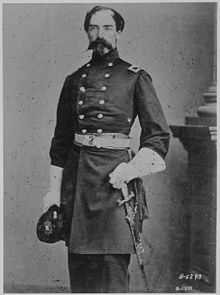Robert Nugent (officer)
| Robert Nugent | |
|---|---|
 | |
| Born |
June 27, 1824 Kilkeel, County Down, Ireland |
| Died |
June 20, 1901 (aged 76) Brooklyn, New York, U.S. |
| Buried at | Cypress Hills National Cemetery |
| Allegiance |
United States of America Union |
| Service/branch | Union Army |
| Years of service | 1861–1879 |
| Rank |
|
| Unit |
Irish Brigade 13th Infantry Regiment 24th Infantry Regiment |
| Commands held | 69th Infantry Regiment |
| Battles/wars |
American Civil War New York Draft Riots American Indian Wars |
Brigadier General Robert Nugent (June 27, 1824 – June 20, 1901) was an Irish-born American U.S. Army officer during the American Civil War and the Indian Wars. He served with the Irish Brigade's 69th Infantry Regiment, from its days as a National Guard unit and into its incorporation into the Union Army at the start of the war, and was one of its senior officers at the First Battle of Bull Run.
When the unit was originally mustered out of service, the 90-day enlistment terms having expired, Nugent accepted a commission as a captain in the regular army. He was immediately assigned to the 13th Infantry Regiment whose commanding officer, Colonel William Tecumseh Sherman, personally requested. Taking a leave of absence to return to New York, he assisted Thomas Francis Meagher in organizing the Irish Brigade. The newly reformed 69th Infantry Regiment was the first unit assigned to the Irish Brigade and, with Nugent as its colonel, he led the "Fighting 69th" at the Battles of Fair Oaks, Gaines Mill, Savage Station, White Oak Swamp, Glendale, Malvern Hill, and Antietam.
Nugent was wounded, shot in the stomach, at the Battle of Fredericksburg and was eventually forced to resign his command. He was appointed acting assistant provost marshal for the southern district of New York, which included New York City and Long Island, by the US War Department. An Irish Catholic and Democrat, his appointment was thought to assure the Irish-American population that conscription efforts would be carried out fairly. The Irish-American, a popular Irish-language newspaper, wrote that the selection was a "wise and deservedly popular one". He did encounter resistance from city officials wanting remain uninvolved, however by mid-June had reported to his superior officer and provost marshal general Colonel James Fry that conscription efforts were "nearing completion without serious incident". Understanding the seriousness of the situation, he attempted to keep the draft selections quiet and in isolated parts of the city. In Manhattan however, lotteries were placed in the heart of Irish tenement and shanty neighborhoods where the draft was most opposed.[1]
In the ensuing New York Draft Riots, Nugent took command of troops and attempted to defend the city against the rioters. Despite issuing the cancellation of the draft, the riots continued for almost a week. His home on West 86th Street was looted and burned by the rioters during that time,[2] his wife and children barely escaping from their home. Upon breaking into his house, furniture was destroyed and paintings of Nugent and Meagher were slashed, although Corcoran's was reportedly left untouched.[3][4]
On October 28, he was relieved of his post and succeeded by General William Hayes. He returning to active duty, he assumed command of Irish Brigade in November 1864, shortly after the death of Brigadier General Michael Corcoran, and was present at the battle of Battle of Spotsylvania, the Petersburg and the Appomattox Campaigns. As its last commanding officer, he and the Irish Brigade also marched in the victory parade held in Washington, D.C. following Lee's surrender at Appomattox Courthouse.[5]
Later years
Nugent was brevetted Brigadier General for distinguished leadership of the 69th Regiment on March 13, 1865. The veterans of the Irish Brigade were honorably discharged and mustered out three months later, Nugent remained in the regular US Army for the next twenty years. A formidable "Indian fighter" during the Great Plains Wars with the 13th and 24th Infantry Regiments. In 1879, he retired at the rank of major and resided in New York where he was involved in the Grand Army of the Republic, the War Veterans' Association of the 7th Regiment and an honorary member of The Old Guard.
Death
He became ill in his old age, complications arising from his wounds suffered at Fredericksburg, and remained bedridden for two months before his death at his McDonough Street home in Brooklyn. In accordance with his last wishes, he was buried at Cypress Hills National Cemetery.[6]
References
- ↑ Bernstein, Iver. The New York City Draft Riots: Their Significance for American Society and Politics in the Age of the Civil War. New York: Oxford University Press, 1991. (pg. 11-13) ISBN 0-19-507130-1
- ↑ Asbury, Herbert. The Gangs of New York: An Informal History of the New York Underworld. New York: Alfred A. Knopf, 1928. (pg. 137) ISBN 1-56025-275-8
- ↑ Bruce, Susannah U.The Harp and the Eagle: Irish-American Volunteers and the Union Army, 1861-1865. New York and London: NYU Press, 2006. (pg. 180) ISBN 0-8147-9940-X
- ↑ Bayor, Ronald H. and Timothy J. Meagher. The New York Irish. Baltimore: Johns Hopkins University Press, 1997. (pg. 204) ISBN 0-8018-5764-3
- ↑ Mahin, Dean B. The Blessed Place of Freedom: Europeans in Civil War America. Dulles, Virginia: Brassey's Inc., 2002. (pg. 236) ISBN 1-57488-523-5
- ↑ "Gen. Robert Nugent Dead; He Was One of the First to Respond to President Lincoln's Call". New York Times.June 21, 1901
Further reading
- Cook, Adrian. The Armies of the Streets: The New York City Draft Riots of 1863. Lexington: University Press of Kentucky, 1974.
- Wylie, Paul R. The Irish General: Thomas Francis Meagher. Norman: University of Oklahoma Press, 2007. ISBN 0-8061-3847-5
External links
- "Robert Nugent". Find a Grave. Retrieved 2008-11-01.